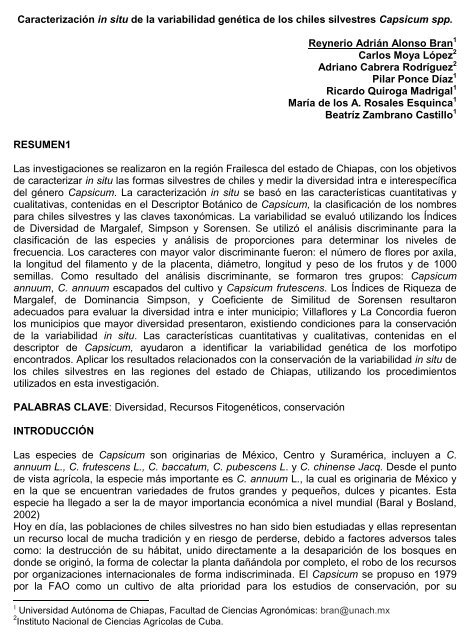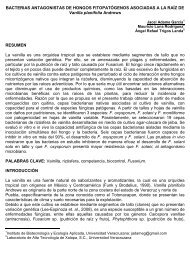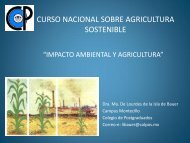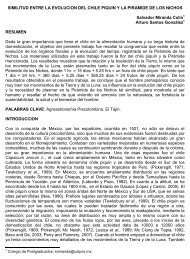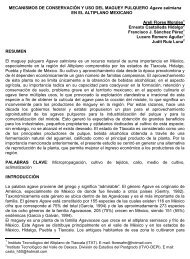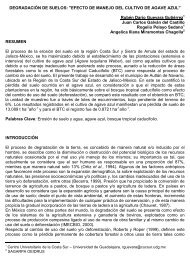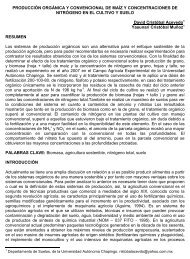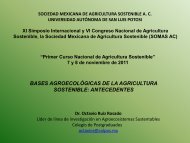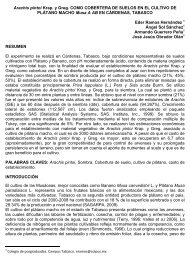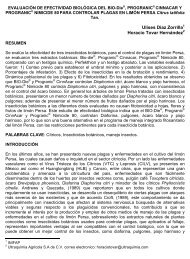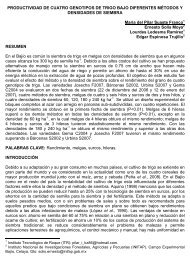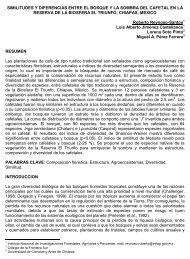Caracterización in situ de la variabilidad genética de los chiles ...
Caracterización in situ de la variabilidad genética de los chiles ...
Caracterización in situ de la variabilidad genética de los chiles ...
You also want an ePaper? Increase the reach of your titles
YUMPU automatically turns print PDFs into web optimized ePapers that Google loves.
Caracterización <strong>in</strong> <strong>situ</strong> <strong>de</strong> <strong>la</strong> <strong>variabilidad</strong> genética <strong>de</strong> <strong>los</strong> <strong>chiles</strong> silvestres Capsicum spp.<br />
Reynerio Adrián Alonso Bran 1<br />
Car<strong>los</strong> Moya López 2<br />
Adriano Cabrera Rodríguez 2<br />
Pi<strong>la</strong>r Ponce Díaz 1<br />
Ricardo Quiroga Madrigal 1<br />
María <strong>de</strong> <strong>los</strong> A. Rosales Esqu<strong>in</strong>ca 1<br />
Beatríz Zambrano Castillo 1<br />
RESUMEN1<br />
Las <strong>in</strong>vestigaciones se realizaron en <strong>la</strong> región Frailesca <strong>de</strong>l estado <strong>de</strong> Chiapas, con <strong>los</strong> objetivos<br />
<strong>de</strong> caracterizar <strong>in</strong> <strong>situ</strong> <strong>la</strong>s formas silvestres <strong>de</strong> <strong>chiles</strong> y medir <strong>la</strong> diversidad <strong>in</strong>tra e <strong>in</strong>terespecífica<br />
<strong>de</strong>l género Capsicum. La caracterización <strong>in</strong> <strong>situ</strong> se basó en <strong>la</strong>s características cuantitativas y<br />
cualitativas, contenidas en el Descriptor Botánico <strong>de</strong> Capsicum, <strong>la</strong> c<strong>la</strong>sificación <strong>de</strong> <strong>los</strong> nombres<br />
para <strong>chiles</strong> silvestres y <strong>la</strong>s c<strong>la</strong>ves taxonómicas. La <strong>variabilidad</strong> se evaluó utilizando <strong>los</strong> Índices<br />
<strong>de</strong> Diversidad <strong>de</strong> Margalef, Simpson y Sorensen. Se utilizó el análisis discrim<strong>in</strong>ante para <strong>la</strong><br />
c<strong>la</strong>sificación <strong>de</strong> <strong>la</strong>s especies y análisis <strong>de</strong> proporciones para <strong>de</strong>term<strong>in</strong>ar <strong>los</strong> niveles <strong>de</strong><br />
frecuencia. Los caracteres con mayor valor discrim<strong>in</strong>ante fueron: el número <strong>de</strong> flores por axi<strong>la</strong>,<br />
<strong>la</strong> longitud <strong>de</strong>l fi<strong>la</strong>mento y <strong>de</strong> <strong>la</strong> p<strong>la</strong>centa, diámetro, longitud y peso <strong>de</strong> <strong>los</strong> frutos y <strong>de</strong> 1000<br />
semil<strong>la</strong>s. Como resultado <strong>de</strong>l análisis discrim<strong>in</strong>ante, se formaron tres grupos: Capsicum<br />
annuum, C. annuum escapados <strong>de</strong>l cultivo y Capsicum frutescens. Los Índices <strong>de</strong> Riqueza <strong>de</strong><br />
Margalef, <strong>de</strong> Dom<strong>in</strong>ancia Simpson, y Coeficiente <strong>de</strong> Similitud <strong>de</strong> Sorensen resultaron<br />
a<strong>de</strong>cuados para evaluar <strong>la</strong> diversidad <strong>in</strong>tra e <strong>in</strong>ter municipio; Vil<strong>la</strong>flores y La Concordia fueron<br />
<strong>los</strong> municipios que mayor diversidad presentaron, existiendo condiciones para <strong>la</strong> conservación<br />
<strong>de</strong> <strong>la</strong> <strong>variabilidad</strong> <strong>in</strong> <strong>situ</strong>. Las características cuantitativas y cualitativas, contenidas en el<br />
<strong>de</strong>scriptor <strong>de</strong> Capsicum, ayudaron a i<strong>de</strong>ntificar <strong>la</strong> <strong>variabilidad</strong> genética <strong>de</strong> <strong>los</strong> morfotipo<br />
encontrados. Aplicar <strong>los</strong> resultados re<strong>la</strong>cionados con <strong>la</strong> conservación <strong>de</strong> <strong>la</strong> <strong>variabilidad</strong> <strong>in</strong> <strong>situ</strong> <strong>de</strong><br />
<strong>los</strong> <strong>chiles</strong> silvestres en <strong>la</strong>s regiones <strong>de</strong>l estado <strong>de</strong> Chiapas, utilizando <strong>los</strong> procedimientos<br />
utilizados en esta <strong>in</strong>vestigación.<br />
PALABRAS CLAVE: Diversidad, Recursos Fitogenéticos, conservación<br />
INTRODUCCIÓN<br />
Las especies <strong>de</strong> Capsicum son orig<strong>in</strong>arias <strong>de</strong> México, Centro y Suramérica, <strong>in</strong>cluyen a C.<br />
annuum L., C. frutescens L., C. baccatum, C. pubescens L. y C. ch<strong>in</strong>ense Jacq. Des<strong>de</strong> el punto<br />
<strong>de</strong> vista agríco<strong>la</strong>, <strong>la</strong> especie más importante es C. annuum L., <strong>la</strong> cual es orig<strong>in</strong>aria <strong>de</strong> México y<br />
en <strong>la</strong> que se encuentran varieda<strong>de</strong>s <strong>de</strong> frutos gran<strong>de</strong>s y pequeños, dulces y picantes. Esta<br />
especie ha llegado a ser <strong>la</strong> <strong>de</strong> mayor importancia económica a nivel mundial (Baral y Bos<strong>la</strong>nd,<br />
2002)<br />
Hoy en día, <strong>la</strong>s pob<strong>la</strong>ciones <strong>de</strong> <strong>chiles</strong> silvestres no han sido bien estudiadas y el<strong>la</strong>s representan<br />
un recurso local <strong>de</strong> mucha tradición y en riesgo <strong>de</strong> per<strong>de</strong>rse, <strong>de</strong>bido a factores adversos tales<br />
como: <strong>la</strong> <strong>de</strong>strucción <strong>de</strong> su hábitat, unido directamente a <strong>la</strong> <strong>de</strong>saparición <strong>de</strong> <strong>los</strong> bosques en<br />
don<strong>de</strong> se orig<strong>in</strong>ó, <strong>la</strong> forma <strong>de</strong> colectar <strong>la</strong> p<strong>la</strong>nta dañándo<strong>la</strong> por completo, el robo <strong>de</strong> <strong>los</strong> recursos<br />
por organizaciones <strong>in</strong>ternacionales <strong>de</strong> forma <strong>in</strong>discrim<strong>in</strong>ada. El Capsicum se propuso en 1979<br />
por <strong>la</strong> FAO como un cultivo <strong>de</strong> alta prioridad para <strong>los</strong> estudios <strong>de</strong> conservación, por su<br />
1 Universidad Autónoma <strong>de</strong> Chiapas, Facultad <strong>de</strong> Ciencias Agronómicas: bran@unach.mx<br />
2 Instituto Nacional <strong>de</strong> Ciencias Agríco<strong>la</strong>s <strong>de</strong> Cuba.
importancia económica y por <strong>la</strong> pérdida en alto grado <strong>de</strong> <strong>la</strong> <strong>variabilidad</strong> natural, consi<strong>de</strong>rando<br />
a<strong>de</strong>más a Mesoamerica (México y Centroamérica) como área <strong>de</strong> máxima prioridad para <strong>la</strong><br />
exploración y estudio <strong>de</strong> estos recursos fitogenéticos. Dicha <strong>de</strong>cisión se tomó por ser un género<br />
nativo <strong>de</strong> esta área geográfica y por <strong>la</strong> gran cantidad <strong>de</strong> especies silvestres que todavía hoy se<br />
<strong>de</strong>scubren (IPGRI, 2001)<br />
Casi <strong>la</strong> totalidad <strong>de</strong> <strong>los</strong> <strong>chiles</strong> silvestres que se comercializan en México son proce<strong>de</strong>ntes <strong>de</strong><br />
colectas, utilizados pr<strong>in</strong>cipalmente a partir <strong>de</strong>l corte <strong>de</strong> <strong>la</strong> p<strong>la</strong>nta entera, <strong>de</strong>struyendo por<br />
completo <strong>la</strong> p<strong>la</strong>nta, lo que, asociado al <strong>de</strong>terioro constante <strong>de</strong> su hábitat, ocasiona <strong>la</strong> ext<strong>in</strong>ción<br />
pau<strong>la</strong>t<strong>in</strong>a <strong>de</strong> <strong>la</strong>s especies <strong>de</strong>l género Capsicum (Montes, 2002). Para lograr programas<br />
sostenibles <strong>de</strong> conservación <strong>de</strong> <strong>los</strong> recursos fitogenéticos <strong>de</strong> cualquier especie, es necesario<br />
comb<strong>in</strong>ar acciones que se <strong>de</strong>sarrollen coord<strong>in</strong>adamente entre <strong>los</strong> centros <strong>de</strong> origen y<br />
domesticación, <strong>la</strong> conservación <strong>in</strong> <strong>situ</strong> y <strong>los</strong> centros especializados para <strong>la</strong> conservación ex <strong>situ</strong>.<br />
Se <strong>de</strong>be realizar <strong>de</strong> forma periódica <strong>la</strong> caracterización morfoagronómica <strong>in</strong> <strong>situ</strong> y <strong>la</strong> evaluación<br />
<strong>de</strong> <strong>la</strong> <strong>variabilidad</strong> observada, a f<strong>in</strong> <strong>de</strong> precisar el <strong>de</strong>sarrollo o no <strong>de</strong> procesos <strong>de</strong> erosión<br />
genética. Es necesario hacer también <strong>la</strong> caracterización <strong>de</strong> <strong>la</strong>s zonas don<strong>de</strong> se encuentran <strong>la</strong>s<br />
pob<strong>la</strong>ciones silvestres, para establecer <strong>la</strong>s re<strong>la</strong>ciones entre <strong>la</strong>s características <strong>de</strong> éstas y <strong>la</strong><br />
supervivencia y <strong>de</strong>sarrollo <strong>de</strong> <strong>la</strong>s p<strong>la</strong>ntas. En este sentido, no se pue<strong>de</strong>n olvidar <strong>la</strong>s<br />
potencialida<strong>de</strong>s que poseen <strong>la</strong>s pob<strong>la</strong>ciones rurales mexicanas en el manejo <strong>de</strong> <strong>la</strong>s especies <strong>de</strong><br />
Capsicum, <strong>la</strong>s cuales podrían aportar mucho en <strong>los</strong> programas <strong>de</strong> conservación <strong>de</strong>l<br />
germop<strong>la</strong>sma existente, pr<strong>in</strong>cipalmente en <strong>la</strong> región Frailesca <strong>de</strong> Chiapas.<br />
Des<strong>de</strong> hace algunos años, se han <strong>de</strong>sarrol<strong>la</strong>do diversos programas dirigidos a promover <strong>la</strong><br />
conservación y uso <strong>de</strong> <strong>los</strong> recursos genéticos <strong>de</strong> <strong>los</strong> <strong>chiles</strong>, pero aún no son suficientes para<br />
conocer <strong>la</strong> <strong>situ</strong>ación real que presentan <strong>los</strong> <strong>chiles</strong> silvestres en <strong>la</strong> región, motivo por el cual se<br />
realizó un estudio <strong>de</strong> <strong>la</strong>s pob<strong>la</strong>ciones <strong>de</strong> <strong>chiles</strong> silvestres en comunida<strong>de</strong>s <strong>de</strong> <strong>la</strong> región Frailesca<br />
<strong>de</strong>l estado <strong>de</strong> Chiapas, con cuyos resultados se propuso resolver <strong>la</strong> siguiente hipótesis: La<br />
caracterización <strong>in</strong> <strong>situ</strong> <strong>de</strong> <strong>la</strong> <strong>variabilidad</strong> genética <strong>de</strong> <strong>los</strong> <strong>chiles</strong> silvestres son <strong>in</strong>dispensables para<br />
trazar estrategias <strong>de</strong> conservación <strong>de</strong> <strong>la</strong>s especies <strong>de</strong> Capsicum en <strong>la</strong> región Frailesca.<br />
Tomando en cuenta <strong>la</strong> hipótesis p<strong>la</strong>nteada en esta <strong>in</strong>vestigación, se estableció el siguiente<br />
objetivo: Realizar <strong>la</strong> caracterización <strong>in</strong> <strong>situ</strong> <strong>de</strong> <strong>la</strong> <strong>variabilidad</strong> presente en <strong>la</strong>s pob<strong>la</strong>ciones <strong>de</strong><br />
<strong>chiles</strong> silvestres en <strong>la</strong> Región Frailesca.<br />
MATERIALES Y MÉTODOS<br />
La <strong>in</strong>vestigación se <strong>de</strong>sarrolló en <strong>la</strong> región <strong>de</strong>nom<strong>in</strong>ada Frailesca en el periodo 2003-2006, se<br />
localiza entre <strong>los</strong> 15º 35´ y 16º 33´ <strong>de</strong> <strong>la</strong>titud norte y entre 92º 15´ y 93º 45´ <strong>de</strong> longitud oeste<br />
con respecto al meridiano <strong>de</strong> Greenwich. Presenta una altitud que va <strong>de</strong>s<strong>de</strong> <strong>los</strong> 400 hasta <strong>los</strong> 1<br />
500 m.s.n.m., ocupa una superficie <strong>de</strong> 8 311 km 2 (11% <strong>de</strong>l total <strong>de</strong>l estado), distribuida en 5<br />
municipios: Vil<strong>la</strong>flores, Vil<strong>la</strong>corzo, Ángel Alb<strong>in</strong>o Corzo, La Concordia y Montecristo <strong>de</strong> Guerrero.<br />
Caracterización <strong>in</strong> <strong>situ</strong> <strong>de</strong> <strong>la</strong> <strong>variabilidad</strong> genética existente <strong>de</strong> <strong>chiles</strong><br />
Para <strong>la</strong> selección <strong>de</strong> <strong>la</strong>s comunida<strong>de</strong>s se utilizó una re<strong>la</strong>ción y un mapa oficial <strong>de</strong> <strong>los</strong> municipios,<br />
comunida<strong>de</strong>s y 3950 campes<strong>in</strong>os registrados como productores <strong>de</strong> <strong>la</strong> SDR y SAGARPA. Las<br />
comunida<strong>de</strong>s, <strong>los</strong> puntos <strong>de</strong> muestreo (p<strong>la</strong>ntas) y <strong>los</strong> campes<strong>in</strong>os, fueron seleccionados al azar<br />
utilizando como mínimo el 10% <strong>de</strong>l total <strong>de</strong> acuerdo con lo utilizado por Cerezal et. al., (2006).<br />
Se utilizó el número <strong>de</strong> viviendas como unidad <strong>de</strong> muestreo, obtenido <strong>de</strong>l XII Censo General <strong>de</strong><br />
Pob<strong>la</strong>ción y Viviendas. La caracterización <strong>in</strong> <strong>situ</strong> <strong>de</strong> <strong>los</strong> tipos <strong>de</strong> <strong>chiles</strong> encontrados en <strong>los</strong><br />
puntos <strong>de</strong> muestreo (huertos, terrenos <strong>de</strong> campes<strong>in</strong>os y bosques) se efectuó siguiendo el<br />
Descriptor <strong>de</strong> Capsicum (AVRDC-IPGRI-CATIE, 1995), evaluándose en el estudio<br />
características cualitativas y cuantitativas <strong>de</strong> <strong>los</strong> mismos. Las variables cuantitativas <strong>de</strong> <strong>la</strong>s<br />
p<strong>la</strong>ntas fueron: altura <strong>de</strong> <strong>la</strong> p<strong>la</strong>nta, (cm); diámetro <strong>de</strong> <strong>la</strong> copa, (cm); longitud <strong>de</strong>l tallo, (cm);<br />
diámetro <strong>de</strong>l tallo, (cm); longitud y diámetro <strong>de</strong> hojas maduras, (cm); longitud <strong>de</strong> coro<strong>la</strong> (cm);
longitud <strong>de</strong> anteras (mm); longitud <strong>de</strong> fi<strong>la</strong>mento (mm); número <strong>de</strong> flores por axi<strong>la</strong>; longitud <strong>de</strong> <strong>la</strong><br />
p<strong>la</strong>centa (cm); longitud <strong>de</strong> frutos (cm); diámetro <strong>de</strong> frutos (cm); peso <strong>de</strong> frutos (g); longitud <strong>de</strong>l<br />
pedicelo (cm); espesor <strong>de</strong> <strong>la</strong> pared <strong>de</strong> frutos (mm); diámetro <strong>de</strong> semil<strong>la</strong>s (mm); peso <strong>de</strong> 1000<br />
semil<strong>la</strong>s (g) y número <strong>de</strong> semil<strong>la</strong>s. También se evaluaron variables cualitativas: posición <strong>de</strong> <strong>la</strong><br />
flor, color <strong>de</strong> <strong>la</strong> flor, color <strong>de</strong> <strong>la</strong>s anteras, exserción <strong>de</strong>l estigma, color <strong>de</strong>l fruto en estado<br />
<strong>in</strong>termedio y maduro, color <strong>de</strong>l fruto y forma <strong>de</strong> fruto. Para caracterizar <strong>los</strong> morfotipos<br />
Miraparriba y Timp<strong>in</strong>chile, <strong>los</strong> más representativos <strong>de</strong> <strong>la</strong>s especies C. frutescens y C. annuum<br />
respectivamente, se utilizaron <strong>la</strong>s variables mencionadas con anterioridad junto a otras c<strong>in</strong>co<br />
altamente discrim<strong>in</strong>antes según AVRDC-IPGRI-CATIE (1995), como son: ciclo <strong>de</strong> vida, color <strong>de</strong>l<br />
tallo, hábito <strong>de</strong> crecimiento, forma <strong>de</strong>l fruto en <strong>la</strong> unión <strong>de</strong>l pedicelo y tipo <strong>de</strong> epi<strong>de</strong>rmis. Para <strong>la</strong><br />
c<strong>la</strong>sificación e i<strong>de</strong>ntificación <strong>de</strong> <strong>la</strong>s muestras, se utilizaron <strong>la</strong>s c<strong>la</strong>ves taxonómicas <strong>de</strong> <strong>la</strong> FAO-<br />
IPGRI (2003). Con <strong>la</strong>s 19 variables cuantitativas se realizó un análisis discrim<strong>in</strong>ante (Hair et. al.,<br />
1999); tomándose como variable <strong>de</strong>pendiente no métrica a <strong>la</strong> especie, con <strong>la</strong> que se<br />
establecieron tres categorías: el primer grupo (1) agrupó a <strong>la</strong>s muestras pertenecientes a C.<br />
annuum, el segundo (2) a C.1frutescens, y el tercero (3) a C. annuum escapados <strong>de</strong>l cultivo.<br />
Como parte <strong>de</strong>l análisis discrim<strong>in</strong>ante, se realizó <strong>la</strong> selección paso a paso <strong>de</strong> aquel<strong>la</strong>s<br />
características que mayor aporte realizaron a <strong>la</strong> discrim<strong>in</strong>ación entre <strong>la</strong>s especies C. annuum y<br />
C. frutescens y C. annuum escapados <strong>de</strong>l cultivo. También como resultado <strong>de</strong>l análisis <strong>de</strong><br />
c<strong>la</strong>sificación <strong>de</strong> <strong>los</strong> grupos <strong>de</strong> diferentes especies <strong>de</strong> Capsicum, se <strong>de</strong>term<strong>in</strong>aron <strong>la</strong>s variables<br />
<strong>de</strong> mayor magnitud re<strong>la</strong>tiva <strong>de</strong>ntro <strong>de</strong> cada Función Discrim<strong>in</strong>ante, consi<strong>de</strong>rando <strong>la</strong>s que más<br />
contribuyeron a <strong>la</strong> discrim<strong>in</strong>ación <strong>de</strong> <strong>la</strong>s especies. Una vez c<strong>la</strong>sificadas <strong>la</strong>s muestras colectadas<br />
por morfotipos, se realizó un análisis <strong>de</strong> proporciones para <strong>de</strong>term<strong>in</strong>ar <strong>la</strong> frecuencia <strong>de</strong> aparición<br />
<strong>de</strong> cada uno <strong>de</strong> el<strong>los</strong>. Por otro <strong>la</strong>do, se evaluó <strong>la</strong> distribución <strong>de</strong> <strong>la</strong>s especies y <strong>de</strong> <strong>los</strong> morfotipos<br />
<strong>de</strong> <strong>chiles</strong> por municipio.<br />
Para <strong>de</strong>term<strong>in</strong>ar cuál o cuáles <strong>de</strong> <strong>los</strong> municipios presentan mayor diversidad <strong>de</strong> <strong>chiles</strong> silvestres<br />
para <strong>la</strong> conservación <strong>in</strong> <strong>situ</strong>, se evaluó en toda <strong>la</strong> región Frailesca y a nivel <strong>de</strong> municipio, <strong>la</strong><br />
riqueza <strong>de</strong> especies o Diversidad Alfa y <strong>la</strong> Diversidad Beta o Diversidad entre hábitat, según<br />
Moreno (2001). La riqueza <strong>de</strong> especies se <strong>de</strong>term<strong>in</strong>ó mediante el índice <strong>de</strong> Margalef, que mi<strong>de</strong><br />
<strong>la</strong> riqueza específica y, el Índice <strong>de</strong> Dom<strong>in</strong>ancia <strong>de</strong> Simpson, que mi<strong>de</strong> <strong>la</strong> estructura <strong>de</strong> <strong>la</strong><br />
comunidad, según <strong>la</strong>s siguientes fórmu<strong>la</strong>s: Índice <strong>de</strong> Riqueza <strong>de</strong> Margalef: ( s 1)<br />
R M<br />
, don<strong>de</strong>: S<br />
ln N<br />
es el número <strong>de</strong> morfotipos y N es el1número total <strong>de</strong> <strong>in</strong>dividuos <strong>de</strong> todos <strong>los</strong> morfotipos.<br />
Índice <strong>de</strong> Dom<strong>in</strong>ancia <strong>de</strong> Simpson: λ=∑ Pi 2 , don<strong>de</strong>: Pi, es el número <strong>de</strong> <strong>in</strong>dividuos <strong>de</strong><br />
un11morfotipo dado entre el número total <strong>de</strong> <strong>in</strong>dividuos. La diversidad entre hábitat, se evaluó a<br />
partir <strong>de</strong>l Coeficiente <strong>de</strong> Similitud <strong>de</strong> Sorensen, siguiendo <strong>la</strong> fórmu<strong>la</strong>: Coeficiente <strong>de</strong> Similitud <strong>de</strong><br />
Sorensen: 2 c , don<strong>de</strong> a y b+..., son el número <strong>de</strong> morfotipos presentes en cada uno <strong>de</strong> <strong>los</strong><br />
Is<br />
a<br />
b<br />
municipios, c es el número <strong>de</strong> morfotipos comunes para <strong>los</strong> municipios. Similitud o disimilitud<br />
entre municipios, en don<strong>de</strong>: c= morfotipos comunes, a+b-c= morfotipos no comunes. c<br />
S<br />
a b c<br />
RESULTADOS Y DISCUSIÓN<br />
Caracterización <strong>in</strong> <strong>situ</strong> <strong>de</strong> <strong>la</strong> <strong>variabilidad</strong> existente.<br />
La c<strong>la</strong>sificación <strong>de</strong> <strong>la</strong>s 386 muestras caracterizadas <strong>in</strong> <strong>situ</strong>, mostró que 151 <strong>de</strong> el<strong>la</strong>s se<br />
correspondían con <strong>la</strong>s características <strong>de</strong> C. frutescens, 12 con <strong>la</strong>s <strong>de</strong> C. annuum escapados <strong>de</strong>l<br />
cultivo y 223 con características <strong>de</strong> C. annuum; <strong>de</strong>ntro <strong>de</strong> éstas últimas se observó que seis <strong>de</strong><br />
el<strong>la</strong>s reunían algunas características <strong>de</strong> C. frutescens (Cuadro 1).
Cuadro 1. C<strong>la</strong>sificación <strong>de</strong> <strong>los</strong> grupos <strong>de</strong> diferentes especies <strong>de</strong> Capsicum encontrados en <strong>la</strong><br />
región Frailesca.<br />
Especie Tamaño <strong>de</strong>l Tamaño <strong>de</strong>l grupo pronosticado según el análisis estadístico<br />
grupo<br />
C. annuum C. C. annuum escapados <strong>de</strong>l cultivo<br />
frutescens<br />
C. annuum<br />
217<br />
6<br />
0<br />
223<br />
(97,3%) (2,7%) 111111111111 (0,0%)<br />
C. frutescens<br />
0<br />
151<br />
0<br />
151<br />
(0,0%) (100,0%)<br />
(0,0%)<br />
C.annuum<br />
escapados<br />
<strong>de</strong>l cultivo<br />
12<br />
0<br />
(0,0%)<br />
0<br />
(0,0%)<br />
12<br />
(100,0%)<br />
Al analizar <strong>los</strong> resultados <strong>de</strong> <strong>la</strong> acción discrim<strong>in</strong>ante <strong>de</strong> <strong>la</strong>s 19 características<br />
cuantitativas1<strong>in</strong>cluidas en el análisis, se obtuvo como resultado que ocho <strong>de</strong> el<strong>la</strong>s mostraron<br />
altos valores (Cuadro 2), fueron <strong>la</strong>s que más contribuyeron a <strong>la</strong> discrim<strong>in</strong>ación entre <strong>la</strong>s<br />
especies. En el cuadro se pue<strong>de</strong> observar otro resultado <strong>de</strong>l análisis realizado, fue <strong>la</strong><br />
<strong>de</strong>term<strong>in</strong>ación <strong>de</strong> <strong>la</strong>s variables <strong>de</strong> mayor magnitud re<strong>la</strong>tiva <strong>de</strong>ntro <strong>de</strong> cada función discrim<strong>in</strong>ante.<br />
Cuadro 2.<br />
Coeficientes1estandarizados1<strong>de</strong>1función1discrim<strong>in</strong>ante1para1especie1<strong>de</strong>1<strong>la</strong>s1ocho1variables<br />
cuantitativas más importantes que caracterizaron a <strong>los</strong> Capsicum.<br />
Coeficiente<br />
Carácter<br />
Función Discrim<strong>in</strong>ante 1 Función Discrim<strong>in</strong>ante 2 Función Discrim<strong>in</strong>ante<br />
Flores por axi<strong>la</strong><br />
Semil<strong>la</strong>s por fruto<br />
Peso 1000 semil<strong>la</strong>s<br />
(g)<br />
Longitud <strong>de</strong>l fruto<br />
(cm)<br />
Long. <strong>de</strong>l fi<strong>la</strong>mento<br />
(cm)<br />
Peso <strong>de</strong>l fruto,1(g)<br />
Long. <strong>de</strong> <strong>la</strong> p<strong>la</strong>centa<br />
(cm)<br />
Diâmetro <strong>de</strong>l fruto<br />
(cm)<br />
3<br />
4.69079 10.1416 5.52769<br />
0.175703 2.20944 -0.205838<br />
13.831 10.4525 16.3075<br />
-0.0708383 0.448327 -2.35444<br />
3.23034 2.40382 4.98408<br />
-0.351076 -0.221955 14.6853<br />
26.7566 27.0157 34.8186<br />
-0.381891 1.38943 7.39585<br />
111111111111<br />
111111111<br />
La característica flores por axi<strong>la</strong>, es una <strong>de</strong> <strong>la</strong>s variables más importantes para diferenciar<br />
morfotipos pertenecientes a <strong>la</strong>s especies C. annuum y C. frutescens, lo que co<strong>in</strong>ci<strong>de</strong> con el<br />
<strong>de</strong>scriptor Botánico <strong>de</strong> Capsicum, <strong>la</strong>s c<strong>la</strong>ves taxonómicas y autores que p<strong>la</strong>ntean que <strong>los</strong> C.<br />
annuum se caracterizan por poseer flores solitarias y <strong>los</strong> C. frutescens poseen más <strong>de</strong> una flor<br />
por axi<strong>la</strong> (Andrews, 1995), también se ha manifestado que <strong>la</strong> condición <strong>de</strong> flor solitaria es <strong>de</strong><br />
herencia simple dom<strong>in</strong>ante, lo cual justifica más su empleo como característica discrim<strong>in</strong>ante.
Vale <strong>de</strong>stacar que <strong>la</strong> longitud <strong>de</strong> <strong>la</strong> p<strong>la</strong>centa y <strong>la</strong> longitud <strong>de</strong>l fi<strong>la</strong>mento <strong>in</strong>fluyeron también en el<br />
agrupamiento <strong>de</strong> <strong>los</strong> <strong>in</strong>dividuos, lo que difiere con el Descriptor Botánico <strong>de</strong> Capsicum, ya que<br />
<strong>la</strong>s mismas no se consi<strong>de</strong>ran por éste como características para <strong>la</strong> diferenciación <strong>de</strong> <strong>la</strong>s<br />
especies. La longitud <strong>de</strong> <strong>la</strong> p<strong>la</strong>centa también es un carácter importante, ya que está<br />
corre<strong>la</strong>cionado con el peso <strong>de</strong> <strong>los</strong> frutos, con <strong>la</strong> resistencia al transporte y con <strong>la</strong> vida <strong>de</strong><br />
anaquel; generalmente es mayor en C. frutescens que en <strong>los</strong> C. annuum; en <strong>la</strong> p<strong>la</strong>centa se<br />
almacena <strong>la</strong> capsic<strong>in</strong>a que <strong>de</strong>term<strong>in</strong>a <strong>la</strong> mayor o menor pungencia <strong>de</strong> <strong>los</strong> frutos. La longitud <strong>de</strong><br />
<strong>la</strong> p<strong>la</strong>centa también <strong>in</strong>fluye en un buen llenado <strong>de</strong> <strong>la</strong>s cavida<strong>de</strong>s <strong>de</strong>l fruto y <strong>la</strong> producción <strong>de</strong><br />
semil<strong>la</strong>s, este último <strong>de</strong> importancia para <strong>la</strong> conservación y preservación <strong>de</strong> <strong>la</strong> especie. La<br />
longitud <strong>de</strong>l fi<strong>la</strong>mento es un carácter <strong>de</strong> importancia biológica, por constituir <strong>la</strong> base <strong>de</strong> <strong>la</strong>s<br />
anteras crecen <strong>de</strong> manera longitud<strong>in</strong>al paralelo al estilo, en <strong>la</strong> mayoría <strong>de</strong> <strong>los</strong> casos son cortos;<br />
a mayor longitud <strong>de</strong> fi<strong>la</strong>mento <strong>la</strong>s anteras cubren mas al estigma, favoreciendo <strong>la</strong><br />
autopol<strong>in</strong>ización y dism<strong>in</strong>uyendo <strong>la</strong> pol<strong>in</strong>ización cruzada a través <strong>de</strong> <strong>los</strong> <strong>in</strong>sectos (Grenleaf,<br />
1986). Al analizar <strong>la</strong>s seis muestras <strong>de</strong> <strong>chiles</strong> silvestres, cuyas características no se<br />
correspondieron totalmente con <strong>la</strong> especie C. annuum, según el análisis discrim<strong>in</strong>ante, se<br />
observó que <strong>la</strong>s magnitu<strong>de</strong>s <strong>de</strong> <strong>la</strong>s variables evaluadas superaron o igua<strong>la</strong>ron <strong>los</strong> valores<br />
obtenidos para <strong>la</strong> especie C. frutescens, tal es el caso <strong>de</strong>l chile a<strong>la</strong>rgado en <strong>los</strong> caracteres:<br />
diámetro <strong>de</strong>l fruto, peso <strong>de</strong> mil semil<strong>la</strong>s y peso <strong>de</strong>l fruto; el chile tomate en longitud <strong>de</strong>l fi<strong>la</strong>mento<br />
y peso <strong>de</strong> mil semil<strong>la</strong>s; el chile ver<strong>de</strong> en longitud <strong>de</strong>l fi<strong>la</strong>mento y <strong>de</strong>l fruto, peso <strong>de</strong> mil semil<strong>la</strong>s y<br />
peso <strong>de</strong>l fruto y Simojovel 1 y 2 en longitud <strong>de</strong>l fi<strong>la</strong>mento y peso <strong>de</strong>l fruto. Aunque éstas<br />
muestras están c<strong>la</strong>sificadas como C. annuum, manifiestan algunas características <strong>de</strong> C.<br />
frutescens, lo que sugiere <strong>la</strong> posibilidad <strong>de</strong> que sean <strong>de</strong>scendientes <strong>de</strong> cruzamientos entre C.<br />
annuum y C. frutescens silvestres (Cuadro 3).<br />
Cuadro 3. Características <strong>de</strong> <strong>la</strong>s seis muestras <strong>de</strong> Capsicum. annuum que según el análisis<br />
discrim<strong>in</strong>ante se asemejan a Capsicum frutescens.<br />
Nombre<br />
común<br />
Diámetr<br />
o <strong>de</strong>l<br />
fruto<br />
(cm)<br />
Longitu<br />
d<br />
<strong>de</strong><br />
fi<strong>la</strong>ment<br />
o (mm)<br />
Longitu<br />
d<br />
<strong>de</strong>l<br />
fruto<br />
(cm)<br />
Longitud<br />
<strong>de</strong><br />
p<strong>la</strong>centa<br />
(**)<br />
Peso <strong>de</strong><br />
1000<br />
semil<strong>la</strong>s<br />
(g)<br />
Peso <strong>de</strong><br />
fruto<br />
(g)<br />
Flores<br />
por<br />
axi<strong>la</strong><br />
Chile<br />
1,3 2,5 5,2 2 3,6 0,5 1 2<br />
a<strong>la</strong>rgado<br />
Pija <strong>de</strong> gato 3,0 3 6,5 3 4,5 15,0 1 2<br />
Chile<br />
2,5 1,9 7,5 3 3,7 15,0 1 1<br />
tomate<br />
Chile ver<strong>de</strong> 1,9 1,8 2,5 3 3,6 0,5 1 3<br />
Simojovel 1 0,7 1,5 2,2 3 2,1 0,4 1 1<br />
Simojovel 2 0,8 1,5 2,1 3 2,1 0,4 1 1<br />
C. annuum* 0,98±0,<br />
03<br />
C.<br />
1,08±0,<br />
frutescens* 03<br />
C. annuum 2,81±0,<br />
escapados 13<br />
<strong>de</strong>l cultivo*<br />
2,04±0,<br />
05<br />
1,92±0,<br />
06<br />
3,04±0,<br />
13<br />
2,21±0,<br />
10<br />
2,72±0,<br />
08<br />
5,95±0,<br />
28<br />
2-3 4,43±0,05 0,72±0,0<br />
4<br />
2-3 3,57±0,01 0,49±0,0<br />
1<br />
3 8,21±0,11 23,05±1,<br />
5<br />
Sem/<br />
fruto<br />
***<br />
1 1-2<br />
2+ 2-3<br />
1 2<br />
* Media ± error estándar;** 1= < ¼ longitud <strong>de</strong>l fruto; 2= ¼ - ½ longitud <strong>de</strong>l fruto, 3= > ½ longitud<br />
<strong>de</strong>l fruto; *** 1= 50<br />
El chile como tal se consi<strong>de</strong>ra un autógamo facultativo, por lo que es capaz <strong>de</strong> autopol<strong>in</strong>izarse y<br />
pol<strong>in</strong>izar a otras p<strong>la</strong>ntas <strong>de</strong>l mismo género. Lo anterior se correspon<strong>de</strong> con <strong>los</strong> resultados <strong>de</strong>
Par<strong>de</strong>y et. al., (2006) quienes afirmaron que existe diversidad genética <strong>de</strong>ntro y entre <strong>la</strong>s<br />
especies <strong>de</strong> Capsicum.<br />
El diámetro y longitud <strong>de</strong> <strong>los</strong> frutos son caracteres corre<strong>la</strong>cionados con el peso <strong>de</strong> éstos,<br />
poseen un alto valor discrim<strong>in</strong>ante y facilitan <strong>la</strong> i<strong>de</strong>ntificación <strong>de</strong> <strong>los</strong> morfotipos, <strong>los</strong> <strong>chiles</strong><br />
silvestres con frutos pequeños tienen mayor <strong>de</strong>manda por ser más picosos que <strong>los</strong> frutos<br />
gran<strong>de</strong>s. El tamaño <strong>de</strong>l fruto es un carácter <strong>de</strong> herencia compleja, resultado <strong>de</strong> <strong>la</strong> <strong>in</strong>teracción <strong>de</strong><br />
varios genes, pero está sujeto a modificaciones consi<strong>de</strong>rables por <strong>los</strong> factores <strong>de</strong>l medio<br />
ambiente. El peso <strong>de</strong> 1000 semil<strong>la</strong>s y el número <strong>de</strong> semil<strong>la</strong>s por fruto están corre<strong>la</strong>cionados con<br />
el peso <strong>de</strong>l fruto y juegan un papel importante en <strong>la</strong> conservación <strong>de</strong> <strong>la</strong>s especies <strong>de</strong> Capsicum.<br />
La asociación entre caracteres pue<strong>de</strong> facilitar <strong>la</strong> i<strong>de</strong>ntificación <strong>de</strong> <strong>la</strong>s especies silvestres. M<strong>in</strong>i y<br />
Kha<strong>de</strong>r (2004), al estudiar <strong>la</strong> <strong>variabilidad</strong> <strong>de</strong> <strong>los</strong> C. annuum silvestres, encontraron también que<br />
el peso promedio <strong>de</strong> <strong>los</strong> frutos es un carácter <strong>de</strong> alto valor discrim<strong>in</strong>ante. Las muestras<br />
pertenecientes a <strong>la</strong> especie C. annuum que presentan flores <strong>de</strong> color b<strong>la</strong>nco (b<strong>la</strong>nco lechoso,<br />
según <strong>la</strong> c<strong>la</strong>ve) representan a <strong>los</strong> morfotipos Timp<strong>in</strong>chile, Simojovel, serranito, Ja<strong>la</strong>peño y<br />
morrón. De el<strong>los</strong>, el Timp<strong>in</strong>chile posee fruto pequeño, ovoi<strong>de</strong> con dos lócu<strong>los</strong> el fruto presenta<br />
diferentes colores: ver<strong>de</strong>, morado, amarillo, anaranjado y rojo <strong>in</strong>tenso. Otro grupo <strong>de</strong> muestras<br />
que poseen flores <strong>de</strong> color b<strong>la</strong>nco verdoso o amarillo verdoso, <strong>in</strong>tegran el resto <strong>de</strong> <strong>los</strong><br />
morfotipos <strong>de</strong> C. annuum representados fundamentalmente por Bolita, miracielo, chile b<strong>la</strong>nco,<br />
pija <strong>de</strong> gato y chile Ja<strong>la</strong>peño. La especie C. frutescens se caracteriza por presentar flores<br />
b<strong>la</strong>nco verdosas, con más <strong>de</strong> una flor por axi<strong>la</strong> (Andrews, 1995), sus muestras presentan frutos<br />
a<strong>la</strong>rgados term<strong>in</strong>ados en punta roma, con dos lócu<strong>los</strong> por fruto. Sobresale en este grupo el<br />
Miraparriba al cual pertenece <strong>la</strong> mayor parte <strong>de</strong> <strong>la</strong>s muestras caracterizadas. Un tercer grupo<br />
formado por muestras <strong>de</strong> C. annuum escapados <strong>de</strong>l cultivo, lo <strong>in</strong>tegran <strong>la</strong> varieda<strong>de</strong>s Ja<strong>la</strong>peño y<br />
morrón; fueron encontrados en huertos y se caracterizan por sus flores b<strong>la</strong>ncas, frutos<br />
a<strong>la</strong>rgados, con tres lócu<strong>los</strong> bien diferenciados.<br />
Distribución <strong>de</strong> <strong>la</strong>1<strong>variabilidad</strong> <strong>de</strong> <strong>los</strong> <strong>chiles</strong> en <strong>la</strong> región Frailesca.<br />
Otro <strong>in</strong>dicador <strong>de</strong> <strong>la</strong> <strong>variabilidad</strong> <strong>de</strong>ntro <strong>de</strong> <strong>la</strong> región Frailesca que se tuvo en cuenta, fue <strong>la</strong><br />
distribución <strong>de</strong> <strong>los</strong> diversos morfotipos <strong>de</strong> chile <strong>in</strong>tra e <strong>in</strong>ter municipios (Cuadro 4).<br />
Cuadro 4. Distribución <strong>de</strong> <strong>la</strong> diversidad <strong>de</strong> <strong>chiles</strong> silvestres en <strong>la</strong> región Frailesca.<br />
Nombre común Especie Municipios<br />
Vil<strong>la</strong>flores Vil<strong>la</strong>corzo Montecristo<br />
Guerrero<br />
La<br />
Concordia<br />
Ángel<br />
A1Corz<br />
o<br />
Cantidad <strong>de</strong> muestras<br />
Timp<strong>in</strong>chile C. 5 24 5 2 11<br />
Chile Bolita annuum 34 17 13 5<br />
Miracielo 5 3 15<br />
Chile b<strong>la</strong>nco 18 1 2<br />
Pija <strong>de</strong> gato 5 5 1 1<br />
Ja<strong>la</strong>peño 9 2<br />
Chile <strong>la</strong>rgo 7<br />
Chile ardil<strong>la</strong> 6<br />
Chile <strong>la</strong>rgucho 6<br />
Chile grosel<strong>la</strong> 4<br />
Siete caldos 1 2 1<br />
Chile morado 2 1<br />
Chile tomate 2 1<br />
Serranito 2<br />
Chile nanchi 2
Chile a<strong>la</strong>rgado 1<br />
Chile <strong>de</strong> mata 1<br />
Chile gran<strong>de</strong> 1<br />
Chile <strong>la</strong>rguito 1<br />
Chile moro 1<br />
Chile morrón 1<br />
Chile pijita 1<br />
Chile p<strong>in</strong>kili 1<br />
Rojo <strong>la</strong>rgo 1<br />
Chile ver<strong>de</strong> 1<br />
Chile guajito 1<br />
H. <strong>de</strong> gallo 1<br />
Chile Oaxaca 1<br />
Simojovel 2<br />
Sub-total 94 50 12 47 32<br />
Miraparriba C. 63 65 22<br />
Tabasqueño frutescen 1<br />
s<br />
Sub-total 64 65 0 22 0<br />
Total<br />
19 7 3 19 4<br />
morfotipos<br />
Total muestras 158 115 12 69 32<br />
Rm* 5.04<br />
Rm* 3.51 1.30 0.82 4.32 0.91<br />
λ** 0.23 0.39 0.38 0.16 0.37<br />
Is*** 0.038<br />
*Rm = Índice <strong>de</strong> Riqueza <strong>de</strong> <strong>la</strong> diversidad <strong>de</strong> Margalef. ** λ = Índice <strong>de</strong> Dom<strong>in</strong>ancia <strong>de</strong> Simpson.<br />
*** Is = Coeficiente <strong>de</strong> Similitud <strong>de</strong> Sørensen.<br />
En toda <strong>la</strong> región se <strong>de</strong>stacó <strong>la</strong> especie C. annuum, por el gran número <strong>de</strong> morfotipo que<br />
presentó (29 en total), lo que <strong>in</strong>dica un alto grado <strong>de</strong> <strong>variabilidad</strong>. S<strong>in</strong> embargo, al analizar <strong>la</strong><br />
especie C. frutescens se observó una menor <strong>variabilidad</strong> <strong>de</strong> morfotipos, <strong>la</strong> que estuvo<br />
representada por el Miraparriba con 150 muestras y Tabasqueño con una. El morfotipo<br />
Miraparriba se <strong>de</strong>staca por encontrarse muy distribuido en <strong>la</strong> región, se encontró en tres <strong>de</strong> <strong>los</strong><br />
c<strong>in</strong>co municipios muestreados (Vil<strong>la</strong>flores, Vil<strong>la</strong>corzo y La Concordia).<br />
En <strong>la</strong> región se manifestó riqueza <strong>de</strong> <strong>la</strong> diversidad, expresada por el valor encontrado <strong>de</strong>l Índice<br />
<strong>de</strong> Margalef, observándose <strong>la</strong> mayor diversidad en <strong>los</strong> municipios La Concordia y Vil<strong>la</strong>flores, <strong>los</strong><br />
que presentaron a su vez una mejor estructura <strong>de</strong> sus respectivas diversida<strong>de</strong>s, tal como<br />
sugieren <strong>los</strong> valores <strong>de</strong>l Índice <strong>de</strong> Dom<strong>in</strong>ancia <strong>de</strong> Simpson; es <strong>de</strong>cir, no hubo una marcada<br />
dom<strong>in</strong>ancia <strong>de</strong> algún o algunos morfotipos sobre otros. En ambos municipios se encontraron <strong>la</strong><br />
misma cantidad <strong>de</strong> morfotipos; pero con menos muestras en La Concordia, lo que motivó que el<br />
valor absoluto <strong>de</strong>l Índice <strong>de</strong> Simpson en este último fuera menor que en el primero (0,16).<br />
En <strong>los</strong> tres municipios restantes, Montecristo <strong>de</strong> Guerrero, Ángel Alb<strong>in</strong>o Corzo y Vil<strong>la</strong> Corzo,<br />
a<strong>de</strong>más <strong>de</strong> encontrarse baja diversidad según el Índice <strong>de</strong> Margalef, se encontró predom<strong>in</strong>io <strong>de</strong><br />
algunos morfotipos sobre otros, según el Índice <strong>de</strong> Simpson; así se tuvo que en <strong>los</strong> dos<br />
primeros, sólo se encontraron muestras <strong>de</strong> <strong>la</strong> especie C. annuum con predom<strong>in</strong>io <strong>de</strong>l<br />
Timp<strong>in</strong>chile y el miracielo; mientras que en Vil<strong>la</strong>corzo, aunque se encontraron morfotipos <strong>de</strong> <strong>la</strong>s<br />
dos especies, predom<strong>in</strong>aron el Timp<strong>in</strong>chile y el chile Bolita <strong>de</strong>ntro <strong>de</strong> <strong>los</strong> C. annuum y el<br />
Miraparriba <strong>de</strong>ntro <strong>de</strong> C. frutescens. El bajo valor <strong>de</strong>l Coeficiente <strong>de</strong> Similitud <strong>de</strong> Sorensen,<br />
observado en <strong>la</strong> Cuadro 5, <strong>de</strong>notó <strong>la</strong> manifestación <strong>de</strong> disimilitud <strong>de</strong>ntro <strong>de</strong> <strong>la</strong> región Frailesca,<br />
s<strong>in</strong> embargo, entre algunos municipios se encontró similitud. La similitud entre <strong>los</strong> municipios
Vil<strong>la</strong>flores y Vil<strong>la</strong>corzo <strong>la</strong> impuso <strong>la</strong> cantidad <strong>de</strong> morfotipos comunes entre ambos, que fue siete,<br />
lo que representó el 37% <strong>de</strong>l total <strong>de</strong> morfotipos en Vil<strong>la</strong>flores, que fué el que presentó mayor<br />
diversidad.<br />
Cuadro 5. Matríz <strong>de</strong> similitud entre <strong>los</strong> municipios <strong>de</strong> <strong>la</strong> región Frailesca, según el Coeficiente <strong>de</strong><br />
Similitud <strong>de</strong> Sorensen.<br />
Municipios Vil<strong>la</strong>corzo La Concordia Montecristo Angel A. Corzo<br />
Vil<strong>la</strong>flores 0,538 0,368 0,181 0,260<br />
Vil<strong>la</strong>corzo 0,423 0,200 0,545<br />
La Concordia 0,272 0,347<br />
Montecristo 0,571<br />
* Los valores seña<strong>la</strong>dos en negritas representan alta similitud<br />
Entre <strong>los</strong> municipios Vil<strong>la</strong>corzo y Ángel Alb<strong>in</strong>o Corzo, solo tuvieron tres morfotipos en común, <strong>la</strong><br />
similitud se <strong>de</strong>bió a que el<strong>los</strong> representaron el 38% <strong>de</strong>l total <strong>de</strong> morfotipos en el municipio <strong>de</strong><br />
mayor diversidad (Vil<strong>la</strong>corzo). F<strong>in</strong>almente, entre <strong>los</strong> municipios Montecristo <strong>de</strong> Guerrero y Ángel<br />
Alb<strong>in</strong>o Corzo, don<strong>de</strong> sólo se encontraron dos morfotipos en común, <strong>la</strong> similitud v<strong>in</strong>o dada<br />
porque <strong>los</strong> mismos representaron el 40% <strong>de</strong> <strong>los</strong> no comunes. Los municipios Vil<strong>la</strong>flores y La<br />
Concordia, fueron <strong>los</strong> que mayor cantidad <strong>de</strong> morfotipos presentaron, solo tuvieron siete en<br />
común, <strong>los</strong> que representaron el 22,5% <strong>de</strong>l total, <strong>de</strong> ahí viene <strong>la</strong> disimilitud encontrada. Entre <strong>los</strong><br />
restantes municipios, a<strong>de</strong>más <strong>de</strong> haber presentado pocos morfotipos en general y comunes<br />
entre el<strong>los</strong>, en n<strong>in</strong>gún caso <strong>la</strong> representatividad <strong>de</strong> <strong>los</strong> últimos llegó al 25%. En <strong>la</strong> Concordia <strong>la</strong>s<br />
áreas <strong>de</strong> pequeños propietarios están <strong>de</strong>bidamente conservados <strong>los</strong> huertos, bosques y<br />
montañas, en <strong>la</strong>s cuales se encuentran <strong>los</strong> <strong>chiles</strong> Bolita y el Miraparriba. El municipio Ángel<br />
Alb<strong>in</strong>o Corzo, sólo se encontraron cuatro morfotipos y 32 muestras. Los tipos <strong>de</strong> <strong>chiles</strong><br />
encontrados en este municipio fueron: Timp<strong>in</strong>chile, chile Bolita y miracielo. Los morfotipos <strong>de</strong><br />
<strong>chiles</strong> encontrados en <strong>la</strong>s dos comunida<strong>de</strong>s que se visitaron en el municipio <strong>de</strong> Montecristo <strong>de</strong><br />
Guerrero son en su mayoría C. annuum, <strong>de</strong>stacándose <strong>los</strong> <strong>de</strong>nom<strong>in</strong>ados Timp<strong>in</strong>chile y el chile<br />
miracielo con c<strong>in</strong>co muestras cada uno, <strong>los</strong> cuales en pequeños huertos.<br />
Caracteres cualitativos como vía <strong>de</strong> i<strong>de</strong>ntificación <strong>de</strong> <strong>los</strong> <strong>chiles</strong> silvestres.<br />
Teniendo en cuenta <strong>la</strong>s características color <strong>de</strong> <strong>la</strong> flor, <strong>de</strong> herencia simple, y el número <strong>de</strong> flores<br />
por axi<strong>la</strong>, se agruparon <strong>la</strong>s muestras <strong>de</strong> chile caracterizadas en tres grupos (Cuadro 6). Se<br />
pue<strong>de</strong> observar que <strong>de</strong>l total <strong>de</strong> muestras, 63 correspondían a <strong>la</strong> especie C. annuum<br />
homocigóticos para flores b<strong>la</strong>ncas, carácter <strong>de</strong> herencia simple recesivo, y una so<strong>la</strong> flor por<br />
axi<strong>la</strong>, <strong>de</strong> herencia simple dom<strong>in</strong>ante, ambos caracterizan <strong>la</strong>s especies <strong>de</strong>s<strong>de</strong> el punto <strong>de</strong> vista<br />
taxonómico. Otro grupo <strong>de</strong> C. annuum fue <strong>in</strong>tegrado por 172 muestras <strong>de</strong>rivadas <strong>de</strong><br />
cruzamientos entre <strong>la</strong>s especies C. annuum y C. frutescens, presentan flores b<strong>la</strong>ncas y<br />
verdosas, uno o varias flores por axi<strong>la</strong> y <strong>de</strong> diferentes tamaños <strong>de</strong> frutos, <strong>los</strong> cuales fueron<br />
i<strong>de</strong>ntificadas como morfotipos pertenecientes a C. annuum y un tercer grupo conformado por<br />
151 muestras con flores <strong>de</strong> color b<strong>la</strong>nco verdoso y más <strong>de</strong> una flor por axi<strong>la</strong> lo que <strong>la</strong>s i<strong>de</strong>ntifica<br />
como C. frutescens, distribuidas en <strong>los</strong> morfotipos Miraparriba y Tabasqueño según <strong>la</strong><br />
c<strong>la</strong>sificación <strong>de</strong> Long (1998).<br />
Cuadro 6. Agrupamiento <strong>de</strong> <strong>la</strong>s muestras <strong>de</strong> Capsicum por especie, según el número <strong>de</strong> flores<br />
por axi<strong>la</strong> y el color <strong>de</strong> <strong>la</strong>s mismas.<br />
Especies<br />
Total<br />
C. annuum 63<br />
C.1frutescens 151<br />
Derivados <strong>de</strong> cruzamientos* 172
Porcentaje<br />
Porcentaje<br />
Total 386<br />
*Muestras pertenecientes a morfotipos evolucionados a partir <strong>de</strong> cruzamientos entre C. annuum<br />
y C. frutescens<br />
El 92% <strong>de</strong> <strong>la</strong>s muestras caracterizadas presentaron flores <strong>de</strong> posición erecta, (Figura11) <strong>la</strong><br />
posición <strong>de</strong> <strong>la</strong> flor es consi<strong>de</strong>rada una característica pr<strong>in</strong>cipal para <strong>la</strong> caracterización <strong>de</strong> éste<br />
género (Dewitt y Bos<strong>la</strong>nd, 1996). El 84% <strong>de</strong> <strong>los</strong> casos presentaron color b<strong>la</strong>nco verdoso, es<br />
característico <strong>de</strong> C. frutescens y algunos C. annuum, también es característico en <strong>la</strong>s muestras<br />
resultantes <strong>de</strong>l cruzamiento natural entre <strong>los</strong> C. annuum y <strong>los</strong> C. frutescens. El 16% <strong>de</strong> <strong>la</strong>s<br />
muestras presentaron <strong>la</strong> coro<strong>la</strong> b<strong>la</strong>nca, lo presentan <strong>la</strong>s C. annuum homocigótico para éste<br />
carácter (Andrews, 1995), <strong>los</strong> morfotipos que presentaron estas características son: Timp<strong>in</strong>chile,<br />
chile Simojovel y <strong>los</strong> cultivados como el Ja<strong>la</strong>peño y morrón. El 92% <strong>de</strong> <strong>la</strong>s muestras presentaron<br />
el estigma exserto. Este aspecto es <strong>de</strong> mucha importancia por consi<strong>de</strong>rar al estigma, el punto<br />
<strong>de</strong> recepción para <strong>la</strong> pol<strong>in</strong>ización en el cruzamiento natural. Onus y Pickersgill (2004)<br />
<strong>in</strong>formaron que el fenómeno <strong>de</strong>l cruzamiento natural en <strong>chiles</strong> es <strong>de</strong>l 75%. Las características<br />
cualitativas son <strong>la</strong>s que con más frecuencia se emplean en <strong>la</strong> diferenciación entre <strong>la</strong>s especies.<br />
Para el caso <strong>de</strong> <strong>la</strong>s flores, en el chile silvestre <strong>la</strong>s pr<strong>in</strong>cipales características cualitativas fueron:<br />
<strong>la</strong> posición, color <strong>de</strong>l fi<strong>la</strong>mento, color <strong>de</strong> <strong>la</strong> coro<strong>la</strong> y <strong>la</strong> exserción <strong>de</strong>l estigma. Las pr<strong>in</strong>cipales<br />
características i<strong>de</strong>ntificables en <strong>los</strong> <strong>chiles</strong> silvestres son <strong>la</strong>s morfológicas, con <strong>la</strong>s cuales se<br />
<strong>de</strong>scriben e i<strong>de</strong>ntifican <strong>la</strong>s especies. En su gran mayoría tienen una alta heredabilidad según<br />
Franco e Hidalgo (2003). Se observó en <strong>los</strong> frutos <strong>variabilidad</strong> en cuanto a color, forma y<br />
tamaño, el 88% son anaranjados (Figura 1). En <strong>los</strong> frutos maduros se encontró que el 75% <strong>de</strong><br />
<strong>los</strong> <strong>chiles</strong> silvestres presentaron coloración rojo c<strong>la</strong>ro. Se agruparonn <strong>los</strong> morfotipos según <strong>la</strong><br />
forma <strong>de</strong>l fruto; se encontraron muestras con frutos a<strong>la</strong>rgados, en el<strong>los</strong> se <strong>in</strong>cluyen: chile<br />
<strong>la</strong>rgucho, chile pija <strong>de</strong> gato, a<strong>la</strong>rgado y pijita (C. annuum). Se encontraron muestras con frutos<br />
casi redondo, características <strong>de</strong> <strong>los</strong> morfotipos: Timp<strong>in</strong>chile, Bolita y grosel<strong>la</strong> (C. annuum) y <strong>de</strong><br />
tipo triangu<strong>la</strong>r: chile b<strong>la</strong>nco, siete caldos y Simojovel (C. annuum), lo que co<strong>in</strong>ci<strong>de</strong> con <strong>la</strong><br />
c<strong>la</strong>sificación realizada por Long (1998). Los morfotipos Miraparriba y Tabasqueño <strong>de</strong> frutos<br />
a<strong>la</strong>rgados pertenecen a <strong>la</strong> especie C. frutescens.<br />
120<br />
100<br />
80<br />
60<br />
40<br />
20<br />
Erecta<br />
Intermedia<br />
B<strong>la</strong>nco<br />
verdoso<br />
B<strong>la</strong>nco<br />
Exserto<br />
Al mismo<br />
nivel<br />
Inserto<br />
100<br />
80<br />
60<br />
40<br />
20<br />
Anaranjado Rojo c<strong>la</strong>ro<br />
Morado<br />
Amarillo<br />
Rojo<br />
Rojo<br />
oscuro<br />
A<strong>la</strong>rgado<br />
Casi<br />
redondo<br />
Triangu<strong>la</strong>r<br />
0<br />
Posición <strong>de</strong> <strong>la</strong> flor Color <strong>de</strong> <strong>la</strong> coro<strong>la</strong><br />
Exserción <strong>de</strong>l<br />
estigma<br />
0<br />
Color <strong>de</strong> fruto<br />
<strong>in</strong>termedio<br />
Color <strong>de</strong> fruto<br />
maduro<br />
Forma <strong>de</strong> fruto<br />
Figura 1. Caracteres cualitativos re<strong>la</strong>cionados con <strong>la</strong>s flores y frutos para <strong>la</strong> i<strong>de</strong>ntificación <strong>de</strong><br />
Capsicum silvestres.<br />
La caracterización <strong>de</strong> <strong>los</strong> morfotipos Timp<strong>in</strong>chile y Miraparriba, utilizando caracteres<br />
cuantitativos y cualitativos como Descriptores mínimos resultantes <strong>de</strong> este trabajo se muestran<br />
en <strong>la</strong> Cuadro 8.<br />
Cuadro 8.Caracterización morfológica <strong>de</strong>l Timp<strong>in</strong>chile Capsicum annuum L. var.<br />
g<strong>la</strong>briusculum1s<strong>in</strong>. avicu<strong>la</strong>re y Miraparriba Capsicum frutescens L.<br />
Carácter Timp<strong>in</strong>chile Miraparriba
Ciclo <strong>de</strong> vida 111111 Perenne 111111111 Anual<br />
Color <strong>de</strong>l tallo 1111 Ver<strong>de</strong> a morado 111111111 Ver<strong>de</strong><br />
Hábito <strong>de</strong> crecimiento 1111 Intermedia a erecta Determ<strong>in</strong>ado<br />
Número <strong>de</strong> flores por axi<strong>la</strong> 111111111 1 11111111112 a 5<br />
Color <strong>de</strong> <strong>la</strong> flor 1111 B<strong>la</strong>nca 111B<strong>la</strong>nco verdoso<br />
Color <strong>de</strong>l fruto <strong>in</strong>termedio 1111 Morado 111111111 Anaranjado<br />
Color <strong>de</strong>l fruto maduro 1111 Rojo oscuro 111111111 Rojo<br />
Forma <strong>de</strong>l fruto 1111 Ovoi<strong>de</strong>, casi redondo 111111111 A<strong>la</strong>rgado<br />
Longitud <strong>de</strong>l fruto 1111 0,5 a 2,1 cm 111111111 3 a 3,5 cm<br />
Diámetro <strong>de</strong> fruto 1111 0,3 a 1,8 cm 111111111 0,6 a 0,7 cm<br />
Forma <strong>de</strong> fruto con pedicelo 1111 Obtuso 111111111 Agudo<br />
Tipo <strong>de</strong> epi<strong>de</strong>rmis 1111 Lisa Semirrugosa<br />
Número semil<strong>la</strong>s por fruto 1111 6 a 17 11 38 a 45 semil<strong>la</strong>s<br />
CONCLUSIONES<br />
Los caracteres longitud <strong>de</strong>l fi<strong>la</strong>mento y <strong>de</strong> <strong>la</strong> p<strong>la</strong>centa, altamente discrim<strong>in</strong>antes son nuevos<br />
caracteres como aportes <strong>de</strong> <strong>la</strong> <strong>in</strong>vestigación que podrían enriquecer el Descriptor.<br />
Los caracteres cuantitativos y cualitativos estudiados podrían consi<strong>de</strong>rarse como una propuesta<br />
<strong>de</strong> Descriptores mínimos en estudios <strong>de</strong> mejoramiento genético y caracterización <strong>de</strong><br />
colecciones.<br />
Estos resultados corroboran <strong>la</strong> posibilidad <strong>de</strong> monitorear <strong>la</strong> <strong>variabilidad</strong> genética presentes en<br />
<strong>los</strong> <strong>chiles</strong> silvestres <strong>de</strong> <strong>la</strong> región.<br />
Aplicar <strong>los</strong> resultados re<strong>la</strong>cionados con <strong>la</strong> conservación <strong>de</strong> <strong>la</strong> <strong>variabilidad</strong> <strong>in</strong> <strong>situ</strong> <strong>de</strong> <strong>los</strong> <strong>chiles</strong><br />
silvestres en <strong>la</strong>s regiones <strong>de</strong> Chiapas, utilizando <strong>los</strong> procedimientos <strong>de</strong> esta <strong>in</strong>vestigación.<br />
AGRADECIMIENTOS<br />
Al PROMEP y a <strong>la</strong> Universidad Autónoma <strong>de</strong> Chiapas por el f<strong>in</strong>anciamiento.<br />
LITERATURA CITADA<br />
Andrews, J.11995. Peppers. The domesticated Capsicums. New edition. Aust<strong>in</strong>: University of<br />
Texas Press. 186 p.<br />
AVRDC-IPGRI-CATIE. 1995. Descriptores <strong>de</strong> Capsicum spp. Roma. 100 p.<br />
Baral, J. B.; Bos<strong>la</strong>nd, P. W.12002. An updated synthesis of the Capsicum genus. Capsicum and<br />
eggp<strong>la</strong>nt Newsletter. 21:11-21.<br />
Cerezal, M. J., Fiallo, R. J., Ramírez, U. L. A., Valledor, E. R., Ruiz, A. A. 2006.1Metodología <strong>de</strong><br />
<strong>la</strong> <strong>in</strong>vestigación y calidad <strong>de</strong> <strong>la</strong> educación. Material Básico. Instituto Pedagógico<br />
Lat<strong>in</strong>oamericano y Caribeño. La Habana, Cuba. 50 p.<br />
Dewitt, D y Bos<strong>la</strong>nd, P. W. 1996. Peppers of the world. An i<strong>de</strong>ntification gui<strong>de</strong>. Edit. Ten speed<br />
Press. 219 p.
FAO-IPGRI. 2003. Recolección <strong>de</strong> <strong>los</strong> Recursos Fitogenéticos en América Lat<strong>in</strong>a y el Caribe:<br />
Historia y perspectivas. IPGRI. (28)(6):11-20.<br />
Franco, T. L.; Hidalgo, R. 2003. Análisis estadístico <strong>de</strong> datos <strong>de</strong> caracterización morfológica <strong>de</strong><br />
recursos fitogenéticos. IPGR. Colombia. 89 p.<br />
Greenleaf, W. H.11986. Bredd<strong>in</strong>g Vegetables Crops. Florida: Ed. University of Florida. 440 p.<br />
Hair, J. F., An<strong>de</strong>rson, R. E., Tathan, R. L., B<strong>la</strong>ck, W. C.1999. Análisis multivariado. Ed. Prentice<br />
Hall. Madrid, España. 415 p.<br />
IPGRI. 2001. Manual técnico para <strong>la</strong> p<strong>la</strong>nificación <strong>de</strong> una colecta <strong>de</strong> germop<strong>la</strong>sma. Roma. 56 p.<br />
Long, S. J.1Capsicum y cultura: La historia <strong>de</strong>l chilli. 1998. Edit. Fondo <strong>de</strong> Cultura<br />
Económica.1México. 203 p.<br />
M<strong>in</strong>i, S., Kha<strong>de</strong>r, A. K. M.12004. Variability, heritability and genetic advance <strong>in</strong> wax type chilli<br />
(Capsicum annuum L.). Capsicum and eggp<strong>la</strong>nt Newsletter. 23:49-52.<br />
Montes, H.S. 2002. Genetic Resources of Chile (Capsicum spp) <strong>in</strong> Mexico. p. 1-3. In:<br />
Proceed<strong>in</strong>gs of the 16th International Pepper Conference. Tampico, Tamaulipas. México.<br />
Moreno, E. C. 2001. Métodos para medir <strong>la</strong> biodiversidad. M y T-Manuales. Zaragoza,<br />
España.1:841<br />
Onus, N. A y Pickersgill, B. 2004. Uni<strong>la</strong>teral Incompatibility <strong>in</strong> Capsicum (So<strong>la</strong>naceae):<br />
Occurrence and Taxonomic Distribution. Annals of Botany. (94)(2):289-295.<br />
Par<strong>de</strong>y R. C., García D. M. A., Vallejo C. F. A. 2006. Caracterización morfológica <strong>de</strong> 100<br />
<strong>in</strong>troducciones <strong>de</strong> Capsicum <strong>de</strong>l Banco <strong>de</strong> Germop<strong>la</strong>sma <strong>de</strong> <strong>la</strong> Universidad Nacional <strong>de</strong><br />
Colombia se<strong>de</strong> Palmira. Acta Agronómica. (55)(3):14-18.


